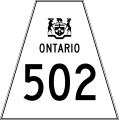Ontario Highway 502
| ||||
|---|---|---|---|---|
| Route information | ||||
| Maintained by the Ministry of Transportation of Ontario | ||||
| Length: | 151.7 km[1] (94.3 mi) | |||
| History: |
1956–1973 (near Napanee) 1980–present[2] (Fort Frances–Dryden) | |||
| Major junctions | ||||
| South end: |
| |||
| North end: |
| |||
| Highway system | ||||
| ||||
Secondary Highway 502, commonly referred to as Highway 502, is a provincially maintained secondary highway in the Canadian province of Ontario. The highway is 151.7 kilometres (94.3 mi) long, connecting Highway 11 east of Fort Frances with Highway 17 in Dryden, via Highway 594. It also carries the Great River Road designation.
The route was constructed throughout the mid- to late 1970s as a new connection between Highway 11 and Highway 17, known as the Manitou Road. It opened in 1980. Another Highway 502 existed between 1956 and 1973, a short alternative route to Highway 2 near Napanee.
Route description
Highway 502 begins at a junction with Highway 11 approximately 30 kilometres (19 mi) east of Fort Frances. It progresses north through an isolated region dominated by the forests, exposed bedrock, rivers, numerous lakes, muskeg and mountains of the Canadian Shield, encountering no communities or significant roads along its 151.7-kilometre (94.3 mi) route; it does provide access to numerous logging and mineral access roads. Highway 502 ends at a junction with Highway 594 approximately 6 kilometres (3.7 mi) west of Dryden and 8 kilometres (5.0 mi) west of Highway 17.[3]
History
Historically, the Ontario Highway 502 designator has been used on two different, unrelated roads.
Belleville Road
Before the completion of Ontario Highway 401 between Belleville and Napanee in the mid-1960s, an Ontario Highway 502 designation appeared briefly on the Belleville Road as a minor bypass road allowing Ontario Highway 2 travellers to bypass Deseronto, Ontario.
Highway 2, as originally designated since the 1920s, did not follow a direct path from Napanee to Belleville. It initially followed the waterfront westward (in the path of the original 1817 stagecoach York Road) through Deseronto, Ontario. The highway would then leave this road to turn northward onto Marysville Road. Marysville Road would intersect with the Belleville Road at Marysville, Hastings County, Ontario. At this point, turning west would put this traffic onto a reasonably-direct route from Marysville to Shannonville where the road rejoined the original York Road and continued westward to Belleville.
A more direct routing is possible by bypassing Deseronto entirely, following the Belleville Road from Napanee directly to Marysville and then onward to Shannonville. At the time Highway 2 was originally designated in the 1920s, Belleville Road was unpaved gravel east of Marysville[4] and a paved (but three miles longer) path through both Deseronto and Marysville was an acceptable trade-off. This would change as traffic volumes increased in the 1950s and 1960s.
By 1960, a 401 segment from Shannonville westward had been completed, as had an extension of the Kingston Bypass eastward to Gananoque and the 1000 Islands Parkway. In other highway sections yet to be bypassed, substantial traffic on the busy Montréal-Toronto corridor by necessity flooded the mostly two-lane Ontario Highway 2. While Highway 2 was left on its existing routing (through both Deseronto and Marysville) the Belleville Road was designated as "Highway 502" in 1956, a bypass which would miss Deseronto entirely and save a few precious miles.[5]
The completion of Highway 401 between Shannonville and Napanee in 1964 would render Highway 502 as a Highway 2 bypass superfluous, although it retained the designation until 1973. While Highway 2 would retain its original routing, the Belleville Road reverted to county jurisdiction (Lennox and Addington County Road 1, Hastings County Road 24).
Northern Ontario
In 1972, planning began for a new route between Highway 11 near Fort Frances and Highway 17 near Dryden. The existing Highway 812 extended north from Highway 11 for approximately 50 kilometres (30 mi), and so work began to extend it north the remaining 100 kilometres (62 mi). During construction, the route was referred to as the Manitou Road. It was completed in the fall of 1980 and designated Highway 502.[2]
For several years in the late 1990s and early 2000s, the highway became used by trucking traffic as an alternative to Ontario Highway 71, after load restrictions were placed on the Sioux Narrows Bridge.[6]
Major intersections
The following table lists the major junctions along Highway 502, as noted by the Ministry of Transportation of Ontario.[1]
| Division | Location | km[1] | mi | Destinations | Notes |
|---|---|---|---|---|---|
| Rainy River | Unorganized Rainy River | 0.0 | 0.0 | ||
| Kenora | Unorganized Kenora | 92.6 | 57.5 | 4th Base Line | |
| Dryden | 151.3 | 94.0 | Access to Highway 17 | ||
| 1.000 mi = 1.609 km; 1.000 km = 0.621 mi | |||||
References
- 1 2 3 Ministry of Transportation of Ontario (2010). "Annual Average Daily Traffic (AADT) counts". Government of Ontario. Retrieved February 17, 2014.
- 1 2 Highway Construction Program: King's and Secondary Highways. Ministry of Transportation and Communications. 1980–1981. p. XIII.
- ↑ Ontario Back Road Atlas (Map). Cartography by MapArt. Peter Heiler. 2010. p. 106. § G4–H5. ISBN 978-1-55198-226-7.
- ↑ "Official Government Road Map of Ontario". Ontario Department of Public Highways, Queen's Park, Toronto. 1930.
- ↑ "Official Government Road Map of Ontario". Queen's Printer for Ontario. 1960.
- ↑ "Sioux Narrows bridge reopens". Sudbury Star, December 23, 2003.

